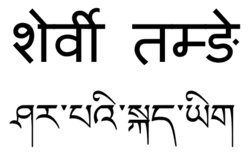Top Qs
Timeline
Chat
Perspective
Sherpa language
Tibetic language From Wikipedia, the free encyclopedia
Remove ads
Sherpa (also Sharpa, Sherwa, or Xiaerba) is a Tibetic language spoken in Nepal and the Indian state of Sikkim, mainly by the Sherpa. The majority speakers of the Sherpa language live in the Khumbu region of Nepal, spanning from the Chinese (Tibetan) border in the east to the Bhotekosi River in the west.[3] About 127,000 speakers live in Nepal (2021 census), some 16,000 in Sikkim, India (2011), and some 800 in the Tibetan Autonomous Region (1994). Sherpa is a subject-object-verb (SOV) language. Sherpa is predominantly a spoken language, although it is occasionally written using either the Devanagari or Tibetan script.[3]
You can help expand this article with text translated from the corresponding article in Nepali. (August 2018) Click [show] for important translation instructions.
|
Remove ads
Geographical distribution
Sherpa is spoken east of the Himalayan region in Nepal Langtang (Rasuwa district) to Olangchungola (Taplejung District) in the following districts of Nepal (Ethnologue).
Classification
Sherpa belongs to the Tibetic branch of the Tibeto-Burman family. It is closely related to Central Tibetan, Jirel, Humla, Mugom, Dolpo, Lo-ke, Nubri, Tsum, Langtang, Kyirong, Yolmo, Gyalsumdo, Kagate, Lhomi, Walung, and Tokpe Gola. The Sherpa language five closely related dialects, these being Solu, Khumbu, Pharak, Dram, and Sikkimese Sherpa.[4]
Phonology
Summarize
Perspective
Sherpa is a tonal language.[5][6] Sherpa has the following consonants:[7]
Consonants
- Stop sounds /p, t̪, ʈ, k/ can be unreleased [p̚, t̪̚, ʈ̚, k̚] in word-final position.
- Palatal sounds /c cʰ ɟ/ can neutralize to velar sounds [k kʰ ɡ] when preceding /i, e, ɛ/.
- /n/ can become a retroflex nasal [ɳ] when preceding a retroflex stop.
- /p/ can have an allophone of [ɸ] when occurring in fast speech.
- /l/ and /r/ are devoiced at the end of a word or before a consonant.
Vowels
- Vowel sounds /i, u/ have the allophones [ɪ, ʊ] when between consonants and in closed syllables.[5]
Tones
There are four distinct tones; high /v́/, high falling /v̂/, low /v̀/, and low rising /v̌/. Regardless of the regular tone of the word, the last syllable of a question is to be pronounced with a rising tone.
Grammar
Summarize
Perspective
Verbs
Verb stems are modified for aspect and mood. The imperfective and perfective aspects and the volitional (whether an action was intentional), infinitive, disjunct, and imperative (commands) moods are differentiated. In verb suffixes, the infinitive, disjunct (action not intended or not known to be intended), past observational, mirative (speaker's surprise), volitional, augmentative (greater intensity), participle, durative (action lasts through an extended time), hortative (plural imperative), dictative (narrating a story), descentive, ablative, and locative are distinguished. A verb stem may take on up to three suffixes. The perfective and imperfective aspects are often treated as past and non-past tenses, respectively. The labels "locative" and "ablative" do not refer to the function of the aspect but rather the homomorphous case-like clitic of the same name. Sherpa is strictly verb-final.
The infinitive also marks the verb of a relative clause and a general action with no specific subject.
ɲɛ
1SG.GEN
pèt̪-u
spill.PRF-INF
čʰū
water
t̪í
DEF
t̪èŋa
cold
nɔ́k
MIR
The water that I spilled is cold
The ablative marking denotes successive actions with some causal relationship.
t̪í-ci
3SG-GEN
dzím-ne
catch.PRF-ABL
gal
go.PRF.DSJT
He caught (it) and went
The locative marking denotes when the action in the main clause is done for the purpose of achieving the action in the locative clause.
d̪am-i
PROPER.FEM-GEN
sa-p-la
eat.IMPF-INF-LOC
sʌma
food
tsò-suŋ
cook.PRF.DSJT-POBS
Damu cooked food in order to eat
The copula(Imperfective hín, perfective hot̪u)is used for existence, location, identity, and adjectival predicates. The evidential particle wɛ́ occurs at the end of phrases to denote an action which the speaker witnessed. The negative particle má is used with perfective verbs.
Nouns
There are four case-like clitics in Sherpa: nominative, genitive, locative, and ablative. These can also be used to mark arguments of a verb. There is a split-ergative system based on aspect; nominative-accusative in the imperfective and ergative-absolutive in the perfective.[8]
Pronouns
Personal pronouns in Sherpa inflect for number and case. Third-person pronouns may be used as demonstratives, and the third person singular nominative also serves as the postnominal definite marker.
There are two articles, which occur phrase-finally. The indefinite form is signaled with the enclitic -i at the end of a noun phrase.
Adjectives
The general word order within noun-phrases is Noun-Adjective. Quantifiers and numerals also follow the noun they modify. Numerals may take on the suffix -pa to denote ordinality or -kʌr to denote collectivity.
Remove ads
Sample text
The following is a sample text in Sherpa of Article 1 of the Universal Declaration of Human Rights:
Sherpa in Tibetan script
- མི་རིགས་ཏེ་རི་རང་དབང་དང་རྩི་མཐོང་གི་ཐོབ་ཐང་འདྲ་འདྲའི་ཐོག་སྐྱེའུ་ཡིན། གང་ག་རྣམ་དཔྱོད་དང་ཤེས་རབ་ལྷན་སྐྱེས་སུ་འོད་དུབ་ཡིན་ཙང་། ཕར་ཚུར་གཅིག་གིས་གཅིག་ལ་སྤུན་གྱི་འདུ་ཤེས་འཇོག་དགོས་ཀྱི།
Sherpa in Devanagari script
- मि रिग ते रि रङ्वाङ् दङ् चिथोङ गि थोप्थङ डडइ थोग् क्येउ यिन्। गङ् ग नम्ज्योद दङ् शेस्रब् ल्हन्क्ये सु ओद्दुब् यिन् चङ् । फर्छुर च्यिग्गि-च्यिग्ल पुन्ग्यि दुशेस् ज्योग्गोग्यि।
Sherpa in IAST transliteration
- Mi rig te ri raṅvāṅ daṅ cithoṅ gi thopthaṅ ḍaḍaï thog kyeu yin. Gaṅ ga namjyod daṅ śesrab lhankye su oddub yin caṅ, pharchur cyiggi-cyigla pungyi duśes jyoggogyi.
Sherpa in the Wylie transliteration
- Mi rigs te ri rang dbang dang rtsi thong gi thob thang 'dra 'dra'i thog skyeu yin. Gang ga rnam dpyod dang shes rab lhan skyes su 'od dub yin tsang, phar tshur gcig gis gcig la spun gyi 'du shes 'jog dgos kyi.
Translation
- Article 1: All human beings are born free and equal in dignity and rights. They are endowed with reason and conscience and should act towards one another in a spirit of brotherhood.
Remove ads
References
External links
Wikiwand - on
Seamless Wikipedia browsing. On steroids.
Remove ads

